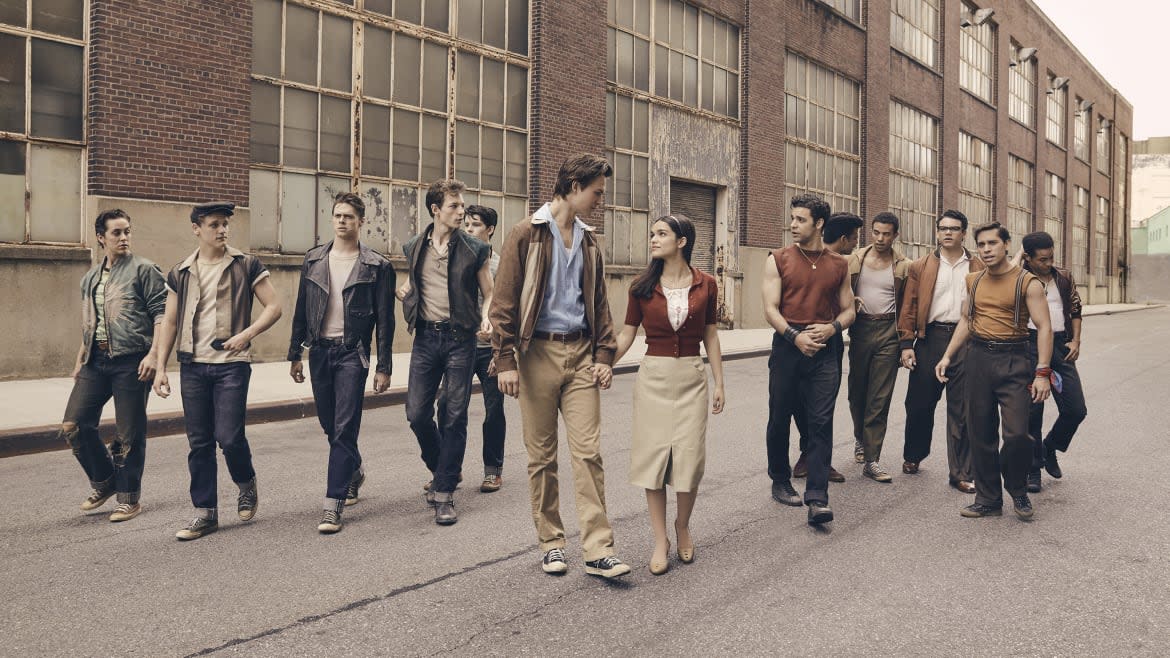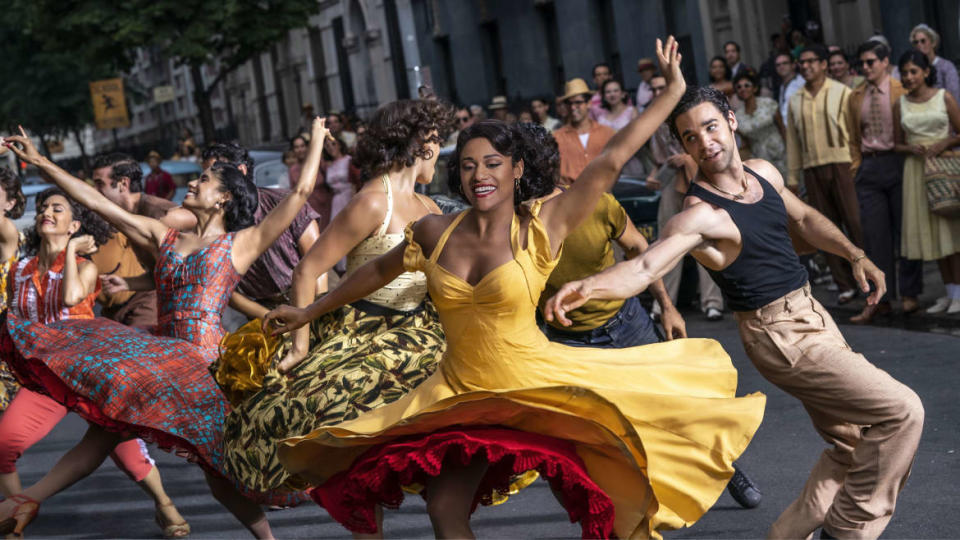Spielberg’s New ‘West Side Story’ Almost Achieves Perfection

- Oops!Something went wrong.Please try again later.
- Oops!Something went wrong.Please try again later.
There are two mammoth questions casting a shadow over the new West Side Story: Why mess with perfection? And, more than that, how?
When it was announced that Steven Spielberg would be making a new version of the classic, with Tony Kushner adapting the screenplay, the project immediately became haunted. The specter of a masterpiece cast a pall over the endeavor. There are valid, necessary criticisms of the 1961 West Side Story film. But, my God, does it hold up, as close to flawless a movie musical—a piece of cinema, period—as there comes.
That shadow only grows when you consider the intimate, unbreakable connection that people have forged with that film in the 60 years since its release. Roots in what it has meant for families, for cultures, for artists, for music lovers, for choreography enthusiasts—for anyone who loves great film—have tangled in our hearts in ways that could never be untethered. And here, in 2021, two white guys, of all people, want to try to outdo that?
That’s where Spielberg’s West Side Story, which hits theaters Dec. 10, works. “Works” is an undersell. It soars. There are no marching orders to outdo or even reinvent.
This West Side Story is faithful and familiar—an homage. There are performances in it that explode off the screen, actors doing right by some of the greatest characters and songs ever written, and then some. There is an escalation of emotion in the second half of the film that builds relentlessly, at once flooding the audience but also buoying them, giving the rapturous air they need to breathe while being entirely overcome.
Mariah Carey Would Like You to Date Me for Christmas
There are remarkable changes made throughout, all in the name of improvement, and nothing blasphemous. Raise your eyebrow over the fact that this first and monumental, well-funded, marketed-to-the-moon remake of West Side Story isn’t helmed or adapted by someone of Latin or Hispanic descent—and keep it there. But cast aside those other shadows and ghosts. The film is spectacular because, well, of course it is.
This is Spielberg finally making his mark in a genre he has borrowed from over the course of his career. But he’s also assembled enough other tools to ascend to the movie-musical mountaintop and deservedly plant his flag in it. This is Kushner, the greatest playwright of our time and a masterful screenwriter. And this is West Side Story, presented with great care and ambition, but also pristine. The ride is so rewarding because it delivers little turbulence on the flight path; you know what you’re going to get, and the quality is good.
There will be a nagging “well, what was the point of it all, then?” that follows the film. There might not be anything renegade here, or an artistic reinterpretation that pokes the bear.
But there is an even stronger counterpoint: One of the greatest musicals of all time, put on screen by one of the greatest directors of our time, improved with the insight of the aforementioned magisterial writer, all filmed with the best in modern camera technology and effects, and performed with the youthful energy of a new generation that has had their lifetime to absorb the significance of material that has been soaked with decades of resonance in American culture.
You could say, perhaps unequivocally, that there is a point to all that.
This is where it’s imperative to pump the breaks. Forget the questions of why or how you mess with perfection. After seeing the new West Side Story, the pertinent one might be: Can you recreate perfection? That answer is a definitive no.
The film starts off slow. Very slow. So slow that you’re forgiven for watching with a grimace, concerned that this whole Spielberg experiment was a giant mistake. There is added exposition, indulgent establishing shots, and then the material itself, a sluggish opening that is exacerbated here. But, almost like a jolt, there’s a turning point, and the whole thing crescendos gorgeously, never letting up. Well, almost never letting up.
First this: Would you believe that casting top-tier musical theater actors whose singing and dancing talents are unparalleled in the world of entertainment—because, you know, they’ve trained their entire lives to be that good—would deliver some of the finest movie-musical performances in recent memory?
This isn’t a hard-and-fast rule. But the times star casting has worked (Andrew Garfield in Tick, Tick...Boom! being a prime recent example) are dwarfed by the tower of great roles and great musicals that have been soiled by A-list stars hired despite being barely able to hold a tune.
Ariana DeBose is a force as Anita. That’s not just because by the time she’s finished “America,” her cyclone of vitality threatens to demolish the rafters and leave nothing but astonished wreckage in its wake. It’s that the humanity she brings to the role is just as potent, and just as brittle. As a series of “unthinkables” happen, falling like dominos, each one bruising her and what she knows about her life harder and deeper, she becomes a vessel of seismic activity. The emotion quakes out of her—have there been more expressive eyes on screen?—until it shakes you, too.
You might not expect it, but the Anita and Maria duet “A Boy Like That/I Have a Love” is the highlight of the film, indicating the value of focusing on emotion over spectacle. That’s owed to DeBose’s titanic performance, but also the astonishing work by Rachel Zegler as Maria, in her film debut. Her crystalline soprano is one thing; her screen presence is otherworldly. Each stare—puppy-eyed at Tony, desperate at Anita, remorseful after the climax’s calamity—radiates as if all of the life force of the room is being summoned as individual lusters, energy that manifests as an additional spotlight on her in every frame.
Mike Faist is a revelation as Riff, elevating the role into more of a central character than it’s ever been, just as David Alvarez’s tender machismo and ferocious dancing has you seeing Bernardo in a new light. The magnitude of the talent in the principal roles, all mostly unknown in Hollywood, makes the dreary, charisma-free performance by Ansel Elgort as Tony all the more glaring—and unforgivable.
Yes, West Side Story has always had a Tony problem. He’s always been a blank slate. A bit of a drip. But between Elgort’s cringey attempt at a New Yawk accent and swagger and the fact that, especially against Zegler, he becomes this black hole of charm, it’s all the more baffling that a movie star was sought after for this role—and that it would be him.
This is a movie that was made by people who care about how their movie looks, which shouldn’t seem like it would be an accomplishment or even like something that’s been missing—until you see it in West Side Story. There’s not a frame of it that couldn’t be frozen to hang on your wall as a piece of art. Not all pieces of art, however, are to everyone’s taste.
For every lush, hypnotizingly vibrant dance sequence, the dancers’ technicolor dresses dazzling while the Sharks and Jets’ youthful athleticism spellbind, the oversaturation of the lighting, which serves the movie well to conjure nostalgia, can just as often register as dull or flat. And worse—especially in the case of Tony and Maria’s courtship scenes—seem corny.
But you’d be hard-pressed to find anyone who thinks the bad outweighs the magnificent here.
Kushner’s delicate adaptation of the source material both shades it with nuance and intensifies its themes and urgency. Notes of racism that have been criticized and rejected over the years have been rectified. But the racial tension that is at the root of the piece’s conflict—that is historic and inescapable, that reverberates now like a generational trauma that has been scabbed, picked at, and bled out again with a grotesque cyclical fervor—is clarified.
More than that, it’s bored into the thing, screwed painfully into the foundation of the material until, in this epic of invigorating dance numbers, swooning ballads, and star-crossed love, the truth of the racial tension is the only piece that’s secure. In this version of West Side Story, you can’t look away from it.
There’s obvious power to that. But also, after all these years since the original stage version or the 1961 film—not to mention the countless productions mounted across the world in the 60 years since—there’s surprise. Unfathomable surprise, even, when you consider the hours we’ve all collectively spent basking in and thinking about this work. West Side Story has been considered a romance, a tragedy, a cultural record, a freeze-frame in time, a commentary on America, a cautionary tale.
This is the first time you view this story—this portrait of a neighborhood at a seismic transition point, this forbidden courtship between Tony and Maria, this unconscionable violence—and see it for what it actually is: an inevitability.
This is a movie that takes place in the ’50s and there’s not a minute of interaction between these characters and cultures that doesn’t remind you of that. That’s what makes its modern resonance all the more agonizing and, hopefully, even after so much time with this material, provocative.

Ariana DeBose as Anita in West Side Story
Not only purists of West Side Story will leave their screenings and, once they’ve dried their eyes, gossiped breathlessly about the tweaks, changes, and, let’s face it, corrections that have been made. It’s all of those people for whom these songs, characters, and choreography are woven into their hearts and memories.
Some are pivotal: the decision to swap the character of Doc out for his widow and then cast Rita Moreno in the role is a stroke of narrative genius. Yes, it’s profound to see the Oscar winner in the new version of the film that made her a star, but it continues Kushner’s mission of deepening the material.
It doesn’t matter whether or not you can suspend disbelief and let your mind stop racing at how poignant Moreno’s presence in the film is. Her character’s beautiful, bittersweet arc is a generational bridge. She carries the scars of the past. She can empathize with the powder keg of frustration the kids are feeling, but she also knows what will happen if they light the fuse.
Beneath all the kinetic energy of West Side Story is an undercurrent of sorrow, something Valentina survives, endures, and fears—the latter because of what’s to come of the culture, of these young people, of future generations if nothing is to change.
We see her stand in a stunning tableau at the most devastating moment in the film, arm in arm with a young man about to accept his punishment. Suddenly, we’re snapped back into the reality of where we are watching this from in 2021. It’s not his punishment. Perhaps it is his fate.
There are other changes that might seem big to some people or go unnoticed to others. “America” is restaged so that it’s a living, breathing number throughout the streets of New York City. How do you make the quintessential movie musical production number even more dynamic than it already was? Spielberg rises to the challenge.
Maybe that’s the nuance here. The challenge might not have been to replicate perfection, or to reinvent a classic. Maybe it was to make it feel alive again. Not new, per se, but reinvigorated. That’s where this West Side Story is a triumph. Mambo!
Get our top stories in your inbox every day. Sign up now!
Daily Beast Membership: Beast Inside goes deeper on the stories that matter to you. Learn more.

